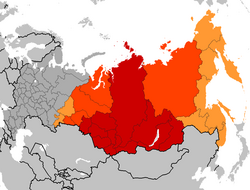Siberia
This article has a list of references or other websites, but its sources are not clear because it does not have inline citations. (October 2021) |
Siberia is the part of Russia that is in Asia. It covers wide landscapes, and stretches from the Ural Mountains to the Pacific. It goes from the Arctic Ocean to the border with China, Kazakhstan, and Mongolia.

The Yenisei river is sometimes called the border between east Siberia and west Siberia. Siberia covers about 70% of all Russian territory, but only 26% of Russians live there. It is one of the coldest places on Earth where people live. 70% of people in Siberia live in cities.
Novosibirsk is the largest city in Siberia, with a population more than 1.5 million. It is on the Eastern coast near to Japan. Omsk and Krasnoyarsk also have populations of over a million people. Tomsk and Kemerovo have populations of over a 500 thousand population. Tomsk is one of the most beautiful places in Siberia. It is said to have the best education in Siberia. Omsk has got very polluted air. This is quite common in Russia, where civilian protests are less effective than in Western countries.
Siberian people
changeMany different ethnic groups live in Siberia. They are sometimes called Sibiryak (Russian: сибиряк) or Sybirak (Russian: сыбирак, from Polish) people. Most people in Siberia who are not Slavic, are Turkic peoples. The first Slavic settlers, from European Russia, arrived in the 17th century.
Related pages
changeSources
change- Russian Siberia: Ethnic History and Traditional Culture
- Groups of Russians of Siberia
- Russians in Siberia
- Russians: ethnographic description Archived 2009-04-19 at the Wayback Machine
- History of Russians in the Krasnoyarsk Territory